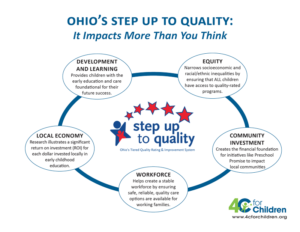 We are grateful to share with you that the future of Step Up To Quality is bright! The State of Ohio budget process has concluded, and some of the changes that had originally been proposed that would have dismantled SUTQ have been removed from the state’s budget. The requirement for those that serve children receiving state assistance to obtain a Step Up To Quality rating will remain in place.
We are grateful to share with you that the future of Step Up To Quality is bright! The State of Ohio budget process has concluded, and some of the changes that had originally been proposed that would have dismantled SUTQ have been removed from the state’s budget. The requirement for those that serve children receiving state assistance to obtain a Step Up To Quality rating will remain in place.
We are inspired at what we can do when we come together with so many in our community who are committed to supporting our youngest learners. Thank you to every child care provider, parent, family, donor, community partner, and supporter of early childhood who sent messages and made calls to our state policy makers. Our voices have been heard and we look forward to continuing to make quality early childhood education for ALL children a reality.
As the Child Care Resource and Referral Agency committed to serving the children, families and providers in our regions we will assess the other budget changes that were made to evaluate the impacts, but we are hopeful that all of the changes make for a state system that better serves families and young children in Ohio.
Here is a brief summary of the changes that impact child care in Ohio:
- It will no longer be mandatory for Child Care Centers and Type A Family Child Care Homes to be highly-rated (a 3-, 4-, or 5-star rating) by June 30, 2025. Programs who receive a 3-star rating or higher will still receive increased reimbursement rates.
- A committee will be created to research the Publicly Funded Child Care (PFCC) and SUTQ systems in Ohio to improve the programs and make them more efficient. One thing the committee will look at is an alternative pathway for a program that enrolls a low number of children receiving PFCC to obtain a one-star rating in SUTQ.
- Eligibility for PFCC has increased to 142% Federal Poverty Level (FPL) and 150% FPL for children with special needs.
- The parameters around future federal dollars was adjusted and now requires ODJFS to use the funds to assist with stabilizing and sustaining child care programs, improve workforce recruitment and retention, and increase access for families.
You can read a general summary of the budget that was passed by the Ohio House and Senate here, and see Governor DeWine’s changes (which did not include changes to any of the impacts around child care above) here.